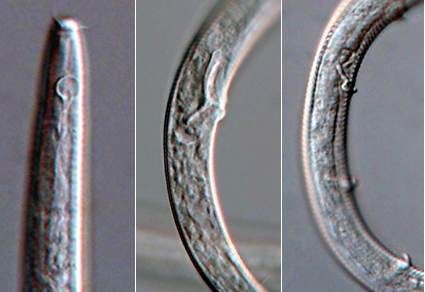Abstract
Two new Leptolaimus species from the Chinese sea area are described and illustrated. Leptolaimus gracilis sp. nov. is characterized by rounded labial region offset from body contour; cephalic setae 5–6 µm long; males with eight tubular and without alveolar supplements, tubular supplements sickle-shaped with pointed tips; spicules arcuated and about 18 µm long; gubernaculum with straight dorso-caudal apophysis; female without supplements, vulva midventral; tail elongate conical. The new species can be easily identified from other known species by males with eight sickle-shaped supplements with pointed tips and the spacing of adjacent supplements almost equal except that of the most anterior two supplements. Leptolaimus hamatus sp. nov. is characterized by small body size; cephalic setae 2–3 µm long; amphidial fovea located 2.6–3.3 times of head diameter from anterior end; male with six tubular and without alveolar supplements, tubular supplements hooked distally; spicules slightly curved, knife-like, 22–24 µm long; gubernaculum with straight dorso-caudal apophysis; females without supplements, vulva situated at right subventral side of body, tail conico-cylindrical.
References
- Chu, M.D., Hao, Y.D. & Huang, Y. (2023) Descriptions of Leptolaimus sinensis sp. nov. and Perspiria brevicaudata sp. nov. (Nematoda) from the Yellow Sea, China. Zootaxa, 5258 (5), 524–536. https://doi.org/10.11646/zootaxa.5258.5.2
- de Jonge, V.N. & Bouwman, L.A. (1977) A simple density separation technique for quantitative isolation of meiobenthos using the colloidal silica Ludox-TM. Marine Biology, 42, 143–148. https://doi.org/10.1007/BF00391564
- de Man, J.G. (1876) Onderzoekingen over vrij in de aarde levende Nematoden. Tijdschrift der Nederlandsche dierkundige Vereeniging, 2, 78–196.
- Gadea, E. (1973) Sobre la filogenia interna de los Nematodos. Instituto de Biologia Aplicada, 54, 87–92.
- Geng, C.X., Hao, Y.D. & Huang, Y. (2021) Description of Leptolaimus boucheri sp. nov. (Nematoda, Leptolaimidae) from the Bohai Sea, China. Journal of Natural History, 55, 2951–2960. https://doi.org/10.1080/00222933.2022.2033868
- Gerlach, S.A. (1958) Die Nematodenfauna der sublitoralen Region in der Kieler Bucht. Kieler Meeresforsch, 14, 64–90.
- Gharahkhani, A., Pourjam, E., Holovachov, O. & Pedram, M. (2020) Phylogenetic relationships of Leptolaimus de Man, 1876 (Plectida: Leptolaimidae) with description of two new species from the Persian Gulf, Iran. In: Nematology. Brill, Leiden, pp. 1–17. https://doi.org/10.1163/15685411-bja10036
- Heip, C., Smol, N. & Vranken, G. (1982) The systematics and ecology of free-living marine nematodes. Helminthological Abstracts, Series B, 51 (1), 1–31.
- Holovachov, O. & Boström, S. (2013) Swedish Plectida (Nematoda). Part 4. The genus Leptolaimus de Man, 1876. Zootaxa, 3739 (1), 1–99. https://doi.org/10.11646/zootaxa.3739.1.1
- Holovachov, O. (2014) Order Plectida Gadea, 1973. In: Schmidt-Rhaesa A (Ed.), Handbook of Zoology, Gastrotricha, Cycloneuralia and Gnathifera. Vol. 2. Nematoda. De Gruyter, Berlin/Boston, pp. 487–535. https://doi.org/10.1515/9783110274257.487
- Huang, Y. & Guo, Y.Q. (2022) Free-living marine nematodes from the East China Sea. Springer, Singapore, 409 pp.
- Lambshead, P.J.D. (2004) Marine nematode biodiversity. In: Chen, Z.X., Chen, S.Y. & Dickson, D.W. (Eds.), Nematology: Advances and Perspectives. Vol 1. Nematode Morphology, Physiology and Ecology. CABI, Wallingford, pp. 438–468. https://doi.org/10.1079/9780851996455.0438
- Leduc, D. (2020) Two new nematode species (Plectida: Leptolaimidae, Rhadinematidae) from Chatham Rise, New Zealand. PeerJ, 8, e9923. https://doi.org/10.7717/peerj.9923
- Leduc, D. (2021) New free-living nematode species and records (Chromadorea: Plectida and Desmodorida) from the edge and axis of Kermadec Trench, Southwest Pacific Ocean. PeerJ, 9, e12037. https://doi.org/10.7717/peerj.12037
- Lorenzen, S. (1972) Leptolaimus-Arten (freilebende Nematoden) aus der Nord- und Ostsee. Kieler Meeresforschungen, XXVIII (1), 92–97.
- McIntyre, A.D. & Warwick, R.M. (1984) Meiofauna techniques. In: Holme, N.A. & McIntyre, A.D. (Eds.), Methods for the study of marine benthos. Blackwell Scientific Publications, Oxford, pp. 217–244.
- Nemys Eds. (2024) Nemys: World Database of Nematodes. Available from: https://nemys.ugent.be (accessed 1 June 2024) https://doi.org/10.14284/366
- Platt, H.M. (1973) Freeliving marine nematodes from Strangford Lough, Northern Ireland. Cahiers de Biologie Marine, 14 (3), 295–321.
- Örley, L. (1880) Az anguillulidák magánrajza. Természettudományi füzetek, 4, 16–150.
- Qiao, C.Y., Jia, S.S. & Huang, Y. (2020) Leptolaimus holovachovi sp. nov. (Nematoda) from Shenzhen mangrove nature reserve of Shenzhen City, China. Journal of Oceanology and Limnology, 38, 1907–1913. https://doi.org/10.1007/s00343-019-9219-1
- Schuurmans Stekhoven, J.H.Jr. & De Coninck, L.A. (1933) Diagnoses of new Belgian marine nemas. Bulletin du Musée Royal d'Histoire Naturelle de Belgique, 9 (4), 1–15.
- Tchesunov, A.V. (2015) Free-living nematode species (Nematoda) dwelling in hydrothermal sites of the North Mid-Atlantic Ridge. Helgoland Marine Research, 69(4), 343–384. https://doi.org/10.1007/s10152-015-0443-6
- Villares, G. & Pastor de Ward, C.T. (2011) New species of Antomicron and Leptolaimus (Nematoda: Leptolaimidae) and record of Procamacolaimus (Nematoda: Camacolaimidae) from Patagonia coast, Chubut and Santa Cruz, Argentina. Journal of the Marine Biological Association of the United Kingdom, 92 (05), 929–939. https://doi.org/10.1017/S0025315411000269


